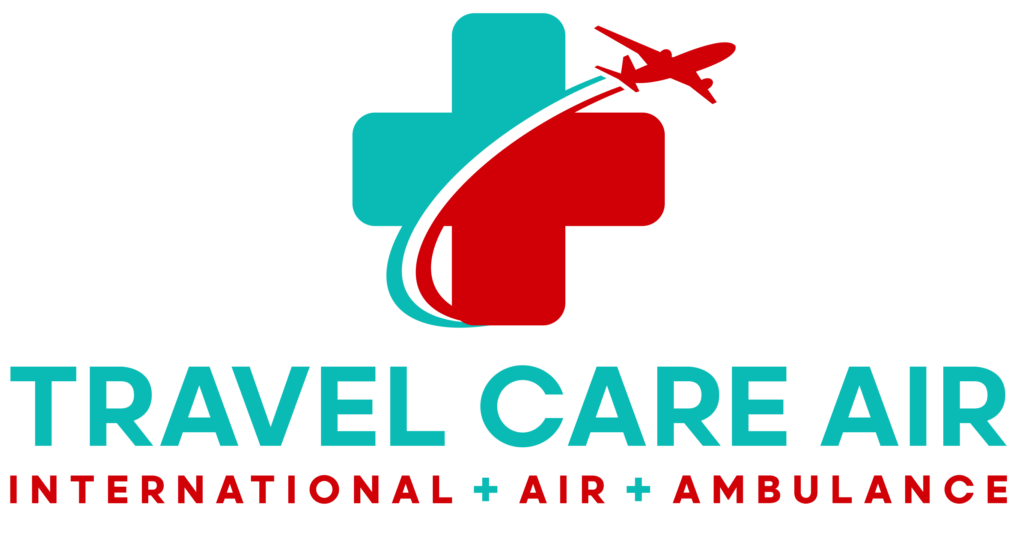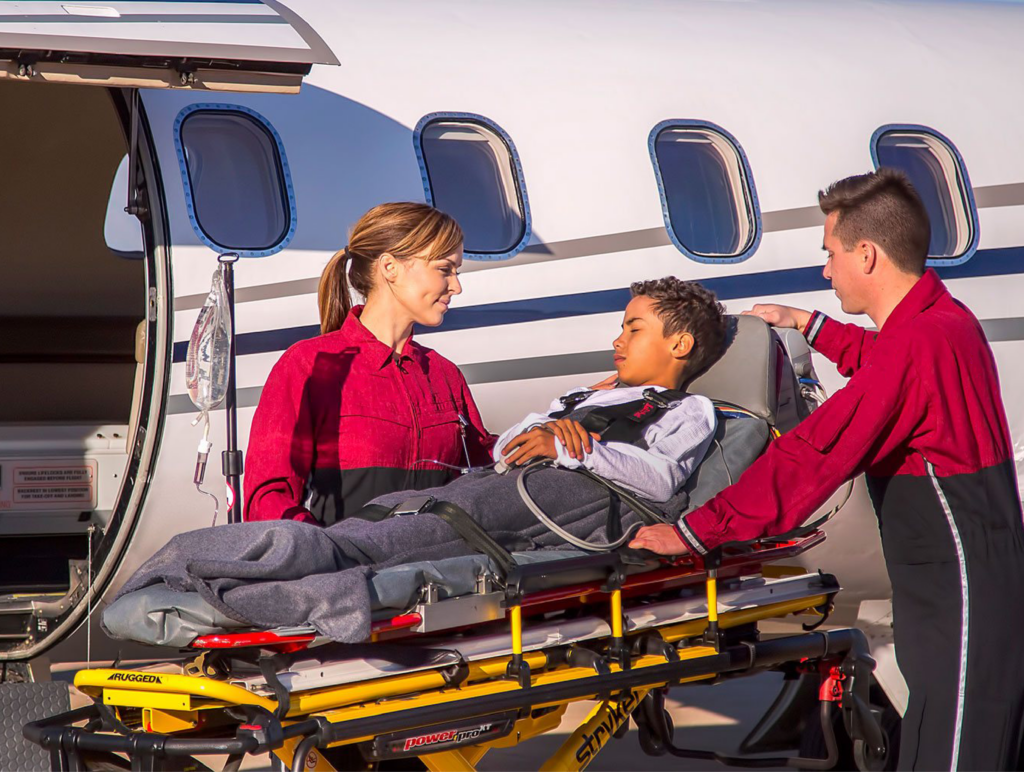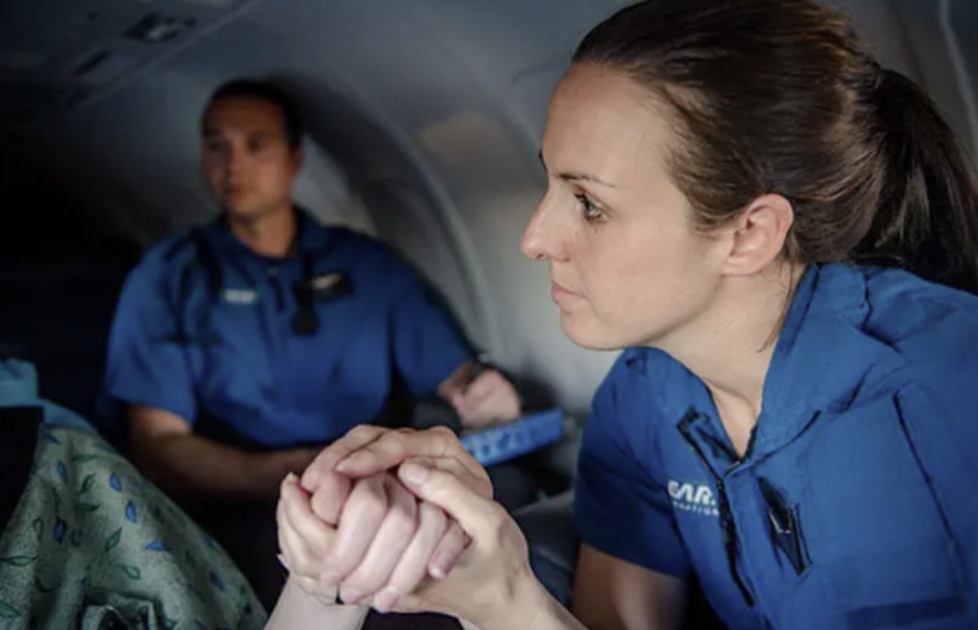When you’re dealing with the logistical challenges of having someone you love flown for medical care, it can become an emotional roller coaster for everyone involved. Fear, urgency, and all of the unknowns can leave families feeling unprepared and completely overwhelmed. Dealing with medical transport means managing both the practical details and some very deep emotions, often in a really short amount of time.
Whether you’re responsible for arranging air ambulance services or are supporting a loved one who’s dealing with a medical flight, it’s okay to feel unsure. What matters most is knowing that there is help available and you don’t have to do it alone. With the right support, families can move through the process with a greater level of clarity and support. At Travel Care Air, we have been helping families that are dealing with medical transport for over 40 years, and we will walk you through what to expect, how to plan, and how to care for both your loved ones, and yourself along the way.
Here’s what you’ll learn:
- How to manage stress during medical flight situations
- What emotional preparation looks like and why it matters
- The important role of the flight nurse and crew support team
- How to plan an air ambulance trip and what to bring with you
- When elderly medical transport or medical escort services are appropriate
- Tips to help you stay calm and confident throughout the entire medical transport process
The Emotional Toll of Medical Transport
Dealing with medical transport is often one of the most emotionally difficult experiences a family will have to face. When a loved one needs to be moved by air for care, the situation can feel rushed and completely out of your hands. Many families experience feelings of fear, helplessness, and that heavy pressure of having to make the right decision as fast as possible.
Dealing with a medical flight brings an added layer of stress because there is usually a great deal of urgency involved, and you might not have the time to fully process what’s happening. This kind of stress during medical flight situations is completely valid and very common.
That’s why emotional awareness matters. Naming what you’re feeling is the first step in managing it. Simple tools like slow, steady breathing, writing down your questions in advance, and making sure you have someone to talk to can help a great deal. Emotional support during an air ambulance trip doesn’t just help the patient…it helps you too.
Planning Ahead for Medical Transport
When it comes to dealing with medical transport, proper preparation is one of the most powerful tools that a family can have. Knowing what to expect, what to ask, and what to bring along with you can ease your anxiety and give you a sense of control in a difficult moment.
Start off by talking with your transport coordinator or medical team. These are the people who are there to guide you through how to plan an air ambulance trip, including what forms and paperwork are needed, who will be onboard, and what kind of care will be provided. Don’t be afraid to ask questions. Getting answers is part of good emotional support during an air ambulance trip.
It also helps to organize the practical things early on. Understanding what to bring on an air ambulance, such as identification, medications, comfort items, and anything that the patient may need at their destination, can ease the stress for everyone involved. Planning ahead gives you the ability to focus on being present and supportive for your loved one.
Who’s Onboard an Air Ambulance
When you’re dealing with medical transport, it can make a big difference to know who will be caring for your loved one during the flight. One of the most important people onboard is the flight nurse, who is specially trained to handle both the medical and emotional needs that can come up during air travel.
The role of a flight nurse is to monitor the patient’s condition, administer any medications if needed, and respond quickly to any changes. But they also offer something equally important…calm, clear communication that reassures both the patient and their family.
In many cases, the team also includes paramedics, respiratory therapists, or a medical escort depending on the level of care that’s required. These professionals are part of comprehensive air ambulance services that prioritize safety, comfort, and care coordination from start to finish.
Knowing that your loved one is in the hands of highly skilled professionals makes a world of difference, and gives you one less thing to worry about.
Special Considerations for Elderly Medical Transport
Elderly medical transport often has some added emotional weight for families. When a parent or aging loved one needs to be moved, there are usually some even bigger worries about their comfort, stability, and how the journey may affect their fragile health.
Older patients may have more complex needs that require a bit of extra planning and care. This is where a medical escort becomes especially valuable, as they can provide both clinical oversight and extra personal reassurance throughout the trip.
Professional elderly medical transport services are designed with these considerations in mind. From soft bedding and in-flight monitoring to thoughtful communication before and after the trip, every detail will help give extra support to the patient’s safety and the family’s peace of mind.
Travel Care Air – Bringing Compassion to Every Mile
Dealing with medical transport can feel emotionally overwhelming, especially when you’re trying to make the right choices under a whole lot of stress. But you don’t have to handle it alone. For over four decades, Travel Care Air has supported families through difficult journeys, offering trusted air ambulance services that prioritize both medical excellence and human compassion.
Whether you need help preparing documents, dealing with emotional stress, or coordinating the entire trip, our experienced team is ready to give you the guidance you need, every step of the way.
Call Travel Care Air today at 1-800-524-7633, or visit us online, to speak with a care coordinator who can walk you through the entire process for your upcoming medical transport.
Frequently Asked Questions
What procedures should be followed when transporting a patient?
When someone requires medical transport, the provider manages every detail. This includes gathering medical records, obtaining doctor clearance, coordinating with both sending and receiving facilities, and arranging qualified medical staff. The goal is seamless, continuous care that ensures safety and comfort throughout the air ambulance journey.
What does it mean to be medically repatriated?
Being medically repatriated means a patient is transported back to their home country or preferred hospital after receiving care elsewhere. This service is especially important for international travelers, long-distance moves, or extended hospital stays abroad. It helps ensure familiar surroundings, local support systems, and ongoing treatment.
Who needs medical repatriation?
Medical repatriation is often needed when a person becomes seriously ill or injured while away from home and requires recovery closer to family or primary care providers. It’s also used for long-term patients needing specialized care that isn’t available locally. Providers ensure a safe, well-managed return process.
How much does an air ambulance cost?
Air ambulance pricing depends on several factors: flight distance, level of medical care required, type of aircraft, and how quickly transport is needed. Costs can range from several thousand to tens of thousands of dollars. Insurance or travel protection plans may help cover all or part of the expenses.
Who pays for an air ambulance?
Payment for an air ambulance can come from private funds, travel insurance, employer benefits, or health insurance. Coverage depends on the policy details and medical necessity. Reputable providers will explain billing upfront and help families understand their options to avoid unexpected costs during a stressful time.
Can I ride in an air ambulance?
In many cases, a family member may accompany the patient, but it depends on the type of aircraft, medical equipment onboard, and the patient’s condition. Always ask in advance. Providers prioritize safety and will let you know what’s possible based on the care plan and flight configuration.


